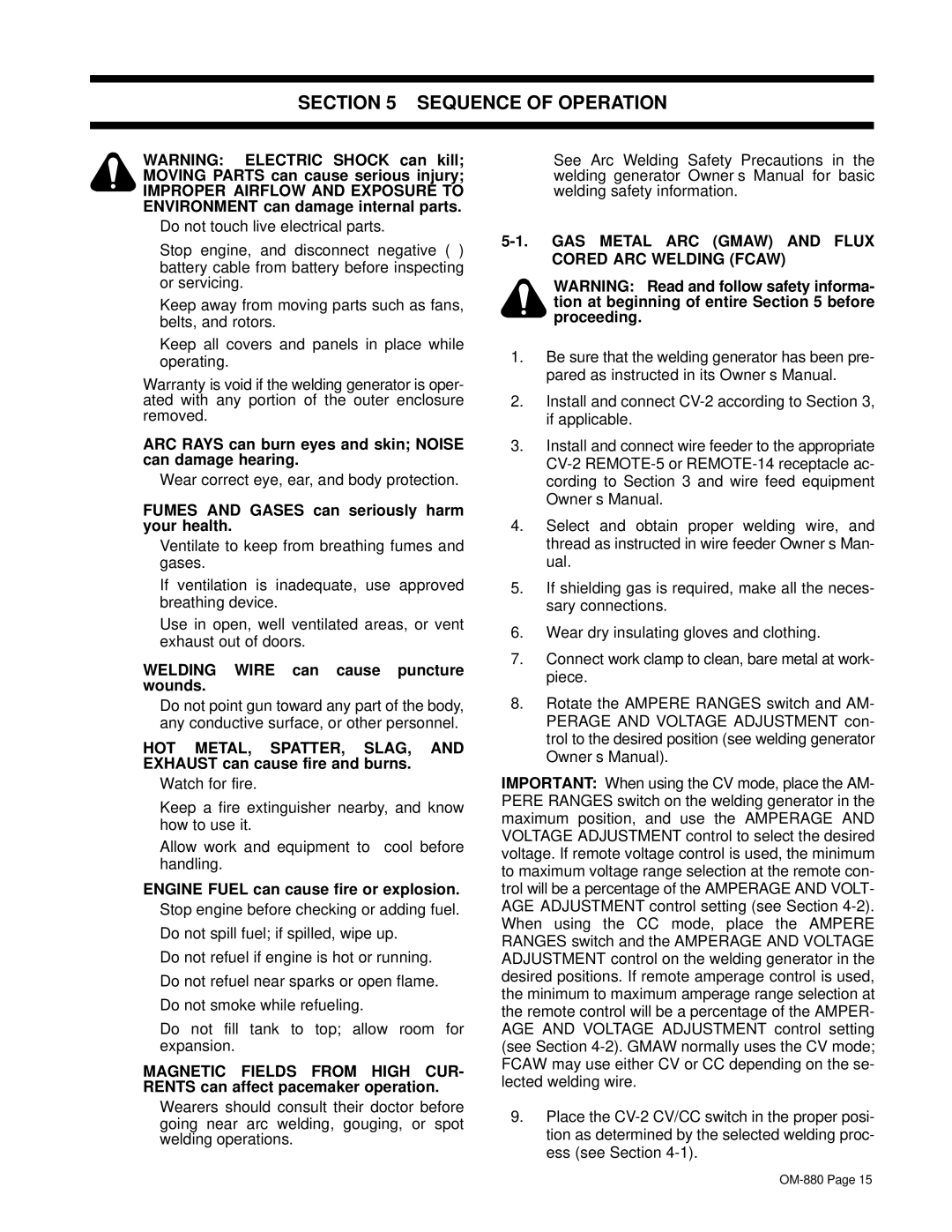
SECTION 5 – SEQUENCE OF OPERATION
WARNING: ELECTRIC SHOCK can kill; MOVING PARTS can cause serious injury;
IMPROPER AIRFLOW AND EXPOSURE TO ENVIRONMENT can damage internal parts.
•Do not touch live electrical parts.
•Stop engine, and disconnect negative
•Keep away from moving parts such as fans, belts, and rotors.
•Keep all covers and panels in place while operating.
Warranty is void if the welding generator is oper- ated with any portion of the outer enclosure removed.
ARC RAYS can burn eyes and skin; NOISE can damage hearing.
•Wear correct eye, ear, and body protection.
FUMES AND GASES can seriously harm your health.
•Ventilate to keep from breathing fumes and gases.
•If ventilation is inadequate, use approved breathing device.
•Use in open, well ventilated areas, or vent exhaust out of doors.
WELDING WIRE can cause puncture wounds.
•Do not point gun toward any part of the body, any conductive surface, or other personnel.
HOT METAL, SPATTER, SLAG, AND EXHAUST can cause fire and burns.
•Watch for fire.
•Keep a fire extinguisher nearby, and know how to use it.
•Allow work and equipment to cool before handling.
ENGINE FUEL can cause fire or explosion.
•Stop engine before checking or adding fuel.
•Do not spill fuel; if spilled, wipe up.
•Do not refuel if engine is hot or running.
•Do not refuel near sparks or open flame.
•Do not smoke while refueling.
•Do not fill tank to top; allow room for expansion.
MAGNETIC FIELDS FROM HIGH CUR- RENTS can affect pacemaker operation.
•Wearers should consult their doctor before going near arc welding, gouging, or spot welding operations.
See Arc Welding Safety Precautions in the welding generator Owner’s Manual for basic welding safety information.
5-1. GAS METAL ARC (GMAW) AND FLUX CORED ARC WELDING (FCAW)
WARNING: Read and follow safety informa- tion at beginning of entire Section 5 before proceeding.
1.Be sure that the welding generator has been pre- pared as instructed in its Owner’s Manual.
2.Install and connect
3.Install and connect wire feeder to the appropriate
4.Select and obtain proper welding wire, and thread as instructed in wire feeder Owner’s Man- ual.
5.If shielding gas is required, make all the neces- sary connections.
6.Wear dry insulating gloves and clothing.
7.Connect work clamp to clean, bare metal at work- piece.
8.Rotate the AMPERE RANGES switch and AM- PERAGE AND VOLTAGE ADJUSTMENT con- trol to the desired position (see welding generator Owner’s Manual).
IMPORTANT: When using the CV mode, place the AM- PERE RANGES switch on the welding generator in the maximum position, and use the AMPERAGE AND VOLTAGE ADJUSTMENT control to select the desired voltage. If remote voltage control is used, the minimum to maximum voltage range selection at the remote con- trol will be a percentage of the AMPERAGE AND VOLT- AGE ADJUSTMENT control setting (see Section
9.Place the
